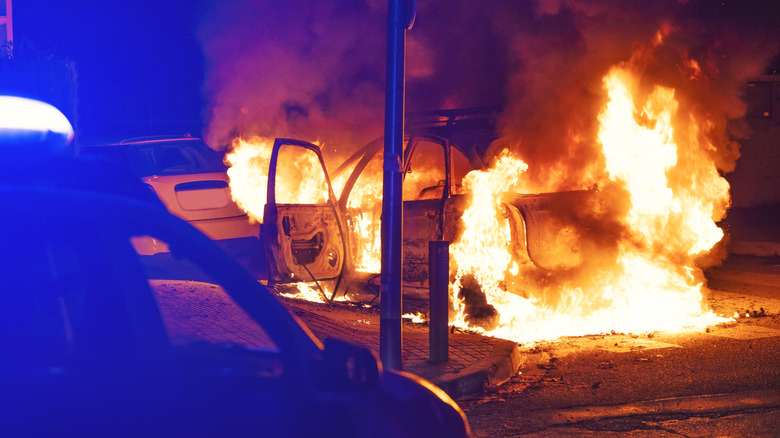The Hard Battle Firefighters Face Putting Out Electric Vehicle Fires
Being a firefighter is one of the toughest jobs out there and goes way beyond just putting out flames. Firefighters often rescue people from dire situations and face unprecedented dangers during emergencies. Although emergency responders are trained to handle all kinds of situations, including vehicle fires, containing EV fires is particularly tricky.
Electric vehicles are fundamentally different from conventional ICE (internal combustion engine)-based automobiles, as the battery packs contain highly combustible electrolytes. Fires in gas-powered cars can also get nasty, but these are much easier to put out. EV fires, on the other hand, can be self-sustaining and spread to other parts of the vehicle. Standard techniques like spraying water aren't as effective because battery packs are often housed inside modules that make cooling them a challenge. Moreover, igniting cells can produce a huge amount of toxic gases like hydrogen fluoride and carbon monoxide, which makes suppressing the fire much more difficult.
EV fires are unpredictable
While EV fires are less common than ICE vehicle fires, they can quickly turn into a disaster due to the lithium-ion battery packs powering the vehicle. Being a known fire hazard is one of the biggest problems with lithium-ion batteries. Although EV manufacturers do a good job at keeping them safe, vehicles can catch fire due to a variety of reasons. Internal and external short circuits and high temperatures due to extreme ambient heat or rapid charging/discharging can lead to EV fires. Electric car makers have recalled their cars over battery-related issues multiple times in the past.
Once a battery pack catches fire, it can release toxic and highly flammable gases like Methane and Hydrogen while also raising the temperature. This can cause the nearby cells to self-ignite under pressure from the released gases and rising temperature, starting a chain reaction known as thermal runaway. The released gases also worsen the situation by catching fire and aggravating the reaction further. As flames can ignite in any part of the battery module, it makes containing the unpredictable fire a challenge for firefighters. Additionally, damaged battery packs can self-ignite hours or days later, making their disposal another big challenge for the authorities.
There is no universal method to put out an EV fire
As of now, there is no single proven method to efficiently put out an EV fire. Most firefighting teams either cool, burn, or submerge the EVs to sustain the fire. However, each has its own caveats. The cool method is the most common, where firefighters go the conventional route and spray the EV with water from fog nozzles. As the battery packs are housed inside sealed modules that prevent the water from cooling the battery, this is often suboptimal. It is hard to reach the vulnerable cells using fog nozzles from a distance, and it can require up to 10,000 liters of water. Additionally, firefighters need to carefully contain the runaway water as it is often contaminated with toxic chemicals from the battery packs.
The burn method is another way of dealing with EV fires, in which firefighters leave the fire to burn through the vehicle and end on its own. As counterintuitive as it may seem, the burn method ensures the battery module burns out completely and the thermal runaway ends after completing its course. The obvious downside to this is that the firefighters can face public and media scrutiny for not doing their job, and it also expels a huge amount of harmful gases into the air. Another technique, known as the submerge method, requires firefighters to dip the burning EV into a pool of water. The process is quick and effective in cooling the battery pack, although thermal runaway can still continue under the water. This, too, requires up to 10,000 liters of water, which needs treatment before further use. Understandably, it can be tricky to arrange such containment units during an emergency.


